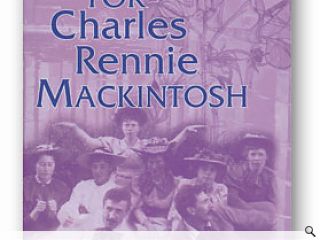The Quest for Charles Rennie Mackintosh
20 Sep 2004
Unusually, John Cairney’s new book on Mackintosh focuses on the person rather than the buildings, and tells emotional tales of love, life and rejection.
The life of Charles Rennie Mackintosh is the stuff of legend: a prodigal talent, a career cut tragically short, a life which ended in exile. The belated recognition of his powers, in Howarth’s book in the ‘50’s, grew into a cult of Mackintosh. Perhaps thanks to that book, he is the one Scottish architect who the world knows, and nowadays it seems inevitable that interest in the work arouses curiosity about its creator.
John Cairney’s The Quest for Charles Rennie Mackintosh is not an architecture book, but instead wholly a book about an architect. We may argue about whether it takes an architect or a critic to write resonantly about buildings: but who should write about the creators of buildings? Perhaps someone who has tried to climb inside Mackintosh’s head, in order to invoke his persona – and John Cairney has played Mackintosh in both stage plays and TV dramas. Cairney brings to this book a great enthusiasm for his subject, a well-meant manifesto – why not build more of unbuilt Mackintosh – and also some primary source interviews of his own.
One of the central thrusts of architectural biography is the attempt to reconcile a designer’s character and personality with the work he created. Is it fair to extrapolate Mackintosh’s sometimes fiery temper, and the black bayes of melancholy which he suffered, into his attitude to clients or even his artistic vision? Cairney’s success is in setting Mackintosh and his close circle, against the running battle he fought with the Establishment. He examines Mackintosh’s relationships with the three women in his life: his mother, who died when he was 17; his first girlfriend, Jessie Keppie, sister of the architect John; and his muse, soul mate and eventual wife, Margaret MacDonald. There is real emotional drama in the book’s set pieces: in his rejection of Jessie Keppie; in the long letters he writes when he is parted from his wife; and finally as he fights back tears for the sake of Margaret, even as he is dying.
Reading about Mackintosh’s unequal struggle should make present-day architects who grumble about the difficulties of securing commissions in Scotland realise that they simply cannot compare themselves to a man who was martyred in his own country while still in this thirties. Mackintosh was rejected by John Keppie, blanked by the commissioning classes in both Glasgow and London, and he was even persona non grata at Glasgow School of Art (he would literally have been “painted out”, Stalinist-style, if not for the efforts of his mentor, Fra Newbery). You might say that Mackintosh couldn’t get arrested: except that the Norfolk constabulary did just that during the Great War.
The book expands on all the pieces of Mackintosh apocrypha which we’re used to, and alongside Blackie, Newbery and the MacDonald sisters, we meet less familiar characters: J.D. Ferguson, Patrick Geddes, the Rosicrucians and the darkly surreal image of a mouse drowning in a chamber pot. Cairney’s writing about Toshie, as he is referred to throughout, draws on self-consciously theatrical turns of phrase, which is true to his own experience, and also to Mackintosh’s links to the theatrical world. There is a peppering of famous quotes; although the notes state that the Hill House was purchased in the Seventies by the RIBA, which is plain wrong.
In these days of cheap production, it’s refreshing to see this hardback, appropriately bound in lilac cloth. Further, it’s great to see a Scottish press producing a popular, non-academic text: and Luath have a broad list which includes radical Scots voices. To accompany 300 pages of text is a handful of small portraits, including the iconic ones, but no images of his work. Cairney writes convincingly about people– but you do also get a sense of the extraordinary flat at Southpark Terrace, now preserved in the Hunterian. This series of luminous rooms is the most powerful sequence in Scottish architecture, and even on its own backs up the claims for Mackintosh’s genius which Cairney frequently asserts.
This book succeeds in answering at least some of the questions it poses about the women, and men, around Mackintosh, and so adds another aspect of Mackintosh’s story to the canon. It is true that, in architectural history, you are nobody until someone publishes a book about you.
Written by Mark Chalmers
Author: John Cairney
Published by: Luath Press, 2004
Price: £16.99
ISBN: 1 84282 058 3
Read next: The Nominees
Read previous: The Art of Structure. Iconic engineering taken to the limit.
Back to September 2004
Browse Features Archive
Search
News
For more news from the industry visit our News section.
Features & Reports
For more information from the industry visit our Features & Reports section.



